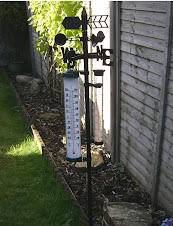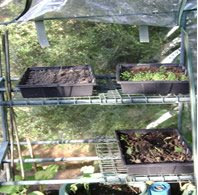One way to protect against slugs and snails is to plant marigolds in beds nearby to your precious vegetables and maybe even your sunflowers - which they just LOVE to reduce to smile-covered stalks! Marigolds, it seems, are plants with which slugs and snails have a particular affinity. It's love at first sight - or sniff!
The golden blooms and the fragranced oh-so-tasty foliage seem to call to the very soul of any creature that slides along the ground on a cushion of slime. They travel for miles, overcoming natural barriers and a veritable maze of cunningly placed slug pellets in order to reach their amour and to taste her sweet green flesh.
The result of this almost certainly one-sided love affair, of course, is a ravaged marigold bed but maybe, just maybe, this is why the runner beans remain as yet unassailed! I wonder whether planting marigolds alongside lettuce would have a similar result. My guess is that in a worse case scenario they would be so torn between the two that they would pause, dazzled by the choice in front of them, long enough that passing hungry birds or frogs would gobble them up! For now, my marigolds continue to "take one for the team".
Monday, 20 July 2009
Wednesday, 15 July 2009
How tall can you go with Spiraclimb?
This is a common question we receive by email and telephone. The canes pictured in my garden are just under 1m. Scientific experiments in controlled conditions (my colleague Dave, me, a Spiraclimb and a tape measure to be precise) have shown the Spiraclimb will go to just under 1.5m tall provided you have a fairly stout cane to mount it on.
Its worth remembering, though, that Spiraclimb is made from galvanised steel, as opposed to elastic, and so the height of the cane doesn't really change much beyond the visual style. A tall cane will draw the spirals in closer to the cane for a taller, narrower spiral whilst a shorter cane, as I opted for, produces wider more shallow spirals.
A consideration for me in selecting the height of the cane was the effect that the hoped-for crop of beans would have and I was seeking to avoid creating more weight then my cane could comfortably support.
With any cane height you can still support much the same length of lateral plant growth and, of course, when the plant reaches the top it can be trained back down again!
Click on the link for additional Spiraclimb growing tips.
Its worth remembering, though, that Spiraclimb is made from galvanised steel, as opposed to elastic, and so the height of the cane doesn't really change much beyond the visual style. A tall cane will draw the spirals in closer to the cane for a taller, narrower spiral whilst a shorter cane, as I opted for, produces wider more shallow spirals.
A consideration for me in selecting the height of the cane was the effect that the hoped-for crop of beans would have and I was seeking to avoid creating more weight then my cane could comfortably support.
With any cane height you can still support much the same length of lateral plant growth and, of course, when the plant reaches the top it can be trained back down again!
Click on the link for additional Spiraclimb growing tips.
Monday, 13 July 2009
Latest pictures from the Spiraclimb Garden!
With the aforementioned mix of sunshine and rain, plus the hungry attention of several nesting birds (who seem to be keeping the slugs at bay) most of my plants are thriving. The Sunflower, sadly, is no more due to slug attack and bizarrely one of my hanging baskets seems to have been savaged also. I may have to investigate this further but early indications suggest Cornish slugs have developed abseiling capabilities, or possibly bungee/parachute training.
Anyhow, the beans are doing well and the first red flowers are peeking through - though I managed to miss them when I took the photos. As with last year's crop they appear to love the Spiraclimb supports and though they do need encouragement not to go off-track once the plants get the idea they really take to them.

Already my beans have grown quite some distance and without Spiraclimb I would be needing a lofty trellis or wigwam type structure by now. As it is, the foliage is starting to fill out nicely and growth is well supported and contained.

Anyhow, the beans are doing well and the first red flowers are peeking through - though I managed to miss them when I took the photos. As with last year's crop they appear to love the Spiraclimb supports and though they do need encouragement not to go off-track once the plants get the idea they really take to them.

Already my beans have grown quite some distance and without Spiraclimb I would be needing a lofty trellis or wigwam type structure by now. As it is, the foliage is starting to fill out nicely and growth is well supported and contained.

Wednesday, 8 July 2009
Keeping on top of things!
We've had a potent combination lately of warm sun and quite a bit of rain and most of the plants are loving it! This is as true of the weeds - which lurk in plentiful supply following the clearing of the patch - as the beans and other plants.
The instructions for Spiraclimb quite rightly say that growing climbers requires little more effort then occasionally twisting the new growth around the support. As previously mentioned, you need to do this quite sympathetically to avoid damaging stems.
However, my beans this year seem to have other ideas and keeping up with them is proving a challenge! For example a day or two's absence from the garden due to rain, or other commitments, finds the beans eagerly pursuing their own agenda instead of mine! I've had to unwrap them from the central cane, each other, and cut short promising bids to cross from one support to the other in order to maintain the correct style and decorum in the garden!
I even had one bean plant that unwrapped itself repeatedly right in front of me after I'd spent minutes carefully arranging it! I steadfastly refuse to use ties as this should not be necessary - but this particular plant has cunning and guile and I almost relented before finally taming it!
Anyhow, the instructions and growing tips on the Spiraclimb website are correct - at least so far - but I think the key, particularly in times of ideal growing weather, is regular attention and possibly greater will power then that of your climbing plant!
The instructions for Spiraclimb quite rightly say that growing climbers requires little more effort then occasionally twisting the new growth around the support. As previously mentioned, you need to do this quite sympathetically to avoid damaging stems.
However, my beans this year seem to have other ideas and keeping up with them is proving a challenge! For example a day or two's absence from the garden due to rain, or other commitments, finds the beans eagerly pursuing their own agenda instead of mine! I've had to unwrap them from the central cane, each other, and cut short promising bids to cross from one support to the other in order to maintain the correct style and decorum in the garden!
I even had one bean plant that unwrapped itself repeatedly right in front of me after I'd spent minutes carefully arranging it! I steadfastly refuse to use ties as this should not be necessary - but this particular plant has cunning and guile and I almost relented before finally taming it!
Anyhow, the instructions and growing tips on the Spiraclimb website are correct - at least so far - but I think the key, particularly in times of ideal growing weather, is regular attention and possibly greater will power then that of your climbing plant!
Labels:
Runner Beans,
Spiraclimb,
The Spiraclimb Garden
Subscribe to:
Posts (Atom)



